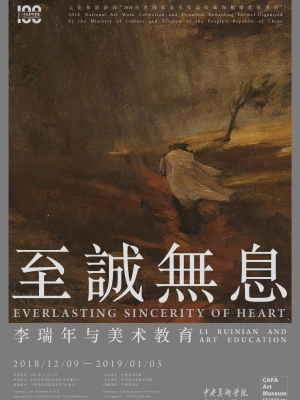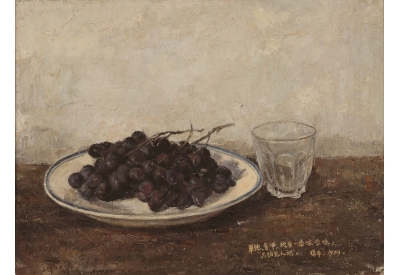
“Everlasting Sincerity of Heart: Li Ruinian and Art Education” is the first concentrated exhibition of Mr. Li Ruinian’s works in CAFA Art Museum and is also another academic reviewing and an in-depth presentation after the “Celebration on the Centenary of the Birth of Li Ruinian and Exhibition of Works Donated by Him” that was held by the National Art Museum of China in 2010. With the gracious support of Mr. Li Ruinian’s family and the joint efforts of staffs of CAFA Art Museum, the exhibition is based on a unique artistic perspective and starts from the growth environment, learning background, friends and hobbies, ideas and methods in teaching, to present Mr. Li Ruinian and his studies in a three-dimensional way, as well as his artworks, and also his artistic educational thoughts are highlighted, in order to commemorate this master of a generation who had taught in the National Beiping Art School and CAFA for many years.
In Chinese art history in the 20th century, Mr. Li Ruinian was an artist who had made outstanding achievements in art creation, especially in the creation and research of oil painting and art education. He went to Europe in the 1930s and studied successively at the Royal Academy of Fine Arts, Belguim and the École Supérieure Libre d’art de Paris, where he conducted a practical and profound study on European oil painting, thus forming a unique artistic character of rigorous modeling and simple painting style. Among the group of Chinese painters who studied abroad in the West at that time, his perfect level of art was very outstanding. After returning to China, he created many amazing oil paintings with meaningful themes and fresh outlook, such as “Rainstorm” and “A Ginkgo Tree”, which not only express his deep concern about the human nature and social reality, but also reveal the artist’s sense of cultural responsibility, showing a high integrity of ideology and artistry. He created a series of landscape paintings describing Chongqing’s suburb district and a number of scenery paintings after the founding of the new China that express a distinct feeling about the local culture and eulogize the natural life. Whether it is on the artistic level or the cultural quality, his artworks reflect the profound academic attainments and show the spirit of Chinese oil painting, making a historical contribution to the development of Chinese oil painting.

Rainstorm 1944 Oil painting 65×80cm

A Ginkgo Tree 1984 Oil painting 132×90cm
Mr. Li Ruinian devoted his life to art education and was committed to exploring and studying the teaching methods and theories of art in colleges and universities. He believed that “the responsibility of teachers lies in guiding students to follow their own way, rather than binding students’ hands with the ways taken by teachers and predecessors before. In the specific teaching method, he was good at enlightening students to observe life, extract materials, study modeling rules and pursue artistic quality. Many well-known artists of Chinese painting and oil painting are Mr. Li’s students and still remember his teaching and kindness. Until his late years, he still focused on the teaching and research of art, traveling extensively with his aged body to practice his education theory, drawing sketches in both the natural landscape and real life, preparing creation, making notes and imparting experience. Just as the theme of this exhibition contains “Everlasting Sincerity of Heart”, “Sincerity” was a core spirit that Mr. Li Ruinian adhered to in his artistic life, which not only had run through his artistic creation but also had been carried out in his education career for many years.
Mr. Li Ruinian once said, “Recalling the past, all sorts of feelings well up in my mind, but I am not ashamed to say that, for decades I have been unrelentingly exploring the road of art.” His life was accompanied by the ups and downs of social culture in the 20th century. His artworks and teaching experience are important materials for reviewing this historical process. On the occasion of the centenary anniversary of CAFA when modern Chinese higher art education has gone through such a special historical moment of a hundred years, the exhibition displays Mr. Li Ruinian’s artworks and teaching concept from the perspective of aesthetic education, and let us to review the extraordinary antecedents of Chinese art and art education and to appreciate the practice and exploration spirit of our predecessors and masters.
For holding this exhibition, MR. Li Ruinian’s children, Mr. Li Dun and Ms. Li Diya, following their mother Ms. Liao Xianzhuang’s legacy, selected excellent works of Mr. Li Ruinian in different periods and donated them to CAFA for permanent collection by the university art museum. These works will become an essential treasure for the teaching and research of CAFA, along with Mr. Li Ruinian’s artistic character and educational achievements, leaving a lasting influence.
“Everlasting Sincerity of Heart: Li Ruinian and Art Education” is the first concentrated exhibition of Mr. Li Ruinian’s works in CAFA Art Museum and is also another academic reviewing and an in-depth presentation after the “Celebration on the Centenary of the Birth of Li Ruinian and Exhibition of Works Donated by Him” that was held by the National Art Museum of China in 2010. With the gracious support of Mr. Li Ruinian’s family and the joint efforts of staffs of CAFA Art Museum, the exhibition is based on a unique artistic perspective and starts from the growth environment, learning background, friends and hobbies, ideas and methods in teaching, to present Mr. Li Ruinian and his studies in a three-dimensional way, as well as his artworks, and also his artistic educational thoughts are highlighted, in order to commemorate this master of a generation who had taught in the National Beiping Art School and CAFA for many years.
In Chinese art history in the 20th century, Mr. Li Ruinian was an artist who had made outstanding achievements in art creation, especially in the creation and research of oil painting and art education. He went to Europe in the 1930s and studied successively at the Royal Academy of Fine Arts, Belguim and the École Supérieure Libre d’art de Paris, where he conducted a practical and profound study on European oil painting, thus forming a unique artistic character of rigorous modeling and simple painting style. Among the group of Chinese painters who studied abroad in the West at that time, his perfect level of art was very outstanding. After returning to China, he created many amazing oil paintings with meaningful themes and fresh outlook, such as “Rainstorm” and “A Ginkgo Tree”, which not only express his deep concern about the human nature and social reality, but also reveal the artist’s sense of cultural responsibility, showing a high integrity of ideology and artistry. He created a series of landscape paintings describing Chongqing’s suburb district and a number of scenery paintings after the founding of the new China that express a distinct feeling about the local culture and eulogize the natural life. Whether it is on the artistic level or the cultural quality, his artworks reflect the profound academic attainments and show the spirit of Chinese oil painting, making a historical contribution to the development of Chinese oil painting.

Rainstorm 1944 Oil painting 65×80cm

A Ginkgo Tree 1984 Oil painting 132×90cm
Mr. Li Ruinian devoted his life to art education and was committed to exploring and studying the teaching methods and theories of art in colleges and universities. He believed that “the responsibility of teachers lies in guiding students to follow their own way, rather than binding students’ hands with the ways taken by teachers and predecessors before. In the specific teaching method, he was good at enlightening students to observe life, extract materials, study modeling rules and pursue artistic quality. Many well-known artists of Chinese painting and oil painting are Mr. Li’s students and still remember his teaching and kindness. Until his late years, he still focused on the teaching and research of art, traveling extensively with his aged body to practice his education theory, drawing sketches in both the natural landscape and real life, preparing creation, making notes and imparting experience. Just as the theme of this exhibition contains “Everlasting Sincerity of Heart”, “Sincerity” was a core spirit that Mr. Li Ruinian adhered to in his artistic life, which not only had run through his artistic creation but also had been carried out in his education career for many years.
Mr. Li Ruinian once said, “Recalling the past, all sorts of feelings well up in my mind, but I am not ashamed to say that, for decades I have been unrelentingly exploring the road of art.” His life was accompanied by the ups and downs of social culture in the 20th century. His artworks and teaching experience are important materials for reviewing this historical process. On the occasion of the centenary anniversary of CAFA when modern Chinese higher art education has gone through such a special historical moment of a hundred years, the exhibition displays Mr. Li Ruinian’s artworks and teaching concept from the perspective of aesthetic education, and let us to review the extraordinary antecedents of Chinese art and art education and to appreciate the practice and exploration spirit of our predecessors and masters.
For holding this exhibition, MR. Li Ruinian’s children, Mr. Li Dun and Ms. Li Diya, following their mother Ms. Liao Xianzhuang’s legacy, selected excellent works of Mr. Li Ruinian in different periods and donated them to CAFA for permanent collection by the university art museum. These works will become an essential treasure for the teaching and research of CAFA, along with Mr. Li Ruinian’s artistic character and educational achievements, leaving a lasting influence.

2018-12-21


